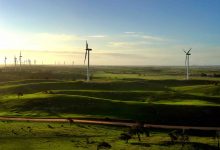Listed renewables developer Infigen Energy says the Tesla big battery that is being built next to its Lake Bonney wind farm will be ready for by around April next year, and more investments in “firming” technologies are certain to follow.
Infigen is investing $28 million into the 25MW/52MWh battery and receiving a further $5 million in funding support from each of the South Australia state government and the Australian Renewable Energy Agency.
One of the prime reasons for the battery is to help Infigen expand its customer and industrial supply contracts, as it helps meet their demand requirements and management the risk profile.
“We will pursue opportunities for additional investment in firming capacity – particularly in SA and NSW,” managing director Ross Rolfe told the annual general meeting on Friday.
“This will enable us to manage our own risk profile as we enter further C&I supply contracts. It will also enable us to generate revenues from the evolving changes in the market that will, or are expected to, reward services that reduce system volatility or instability.”
However, Infigen immediate investments in new “firming” capacity are likely to be weighted more towards open cycle gas, diesel or pumped hydro, because the rules of the market do not yet favour battery storage, and battery storage costs need to fall further.
The original Tesla big battery at Neoen’s Hornsdale wind farm has highlighted its capabilities – particularly its speed, accuracy and flexibility and ability to add to system security – but many of the markets it plays in are not yet developed.
The so-called 5-minute settlement rule won’t take effect until 2021, and there is little revenue in fast-response. So, until battery storage costs fall further it is harder to make ends meet in the current market set-up, Infigen believes.
The Lake Bonney battery will be one of a number of new batteries entering the South Australia grid next year, following the original 100MW/129MWh Tesla big battery at Hornsdale, and the delayed and yet-to-be-complete 30MW/8MWh Daylrymple North battery at the Wattle Point wind farm.
The Lincoln Gap wind farm near Port Augusta recently chose Fluence to provide a 10MW/10MWh battery, while Tilt is still mulling options for the battery to be sited next to the Snowtown wind farm and a new adjoining solar farm.
Rolfe said the Lake Bonney project is currently under construction and is, “at this stage, on time and on budget. We expect the battery to be fully commissioned by Q4, FY2019. This will enable us to contract, at least, a further 18MW of production from our lake Bonney assets.
Earlier, chairman Len Gill noted that access to energy storage also creates the ability to supply ancillary services, ensuring increased security and quality of supply and fast response services as demand requires.
Infigen is playing its role in ensuring that the system remains secure and reliable, while transitioning to a generation mix comprising dispatchable and intermittent generation with a lower carbon emissions footprint,” Gill said.
“Our investment in firming technology with our grid scale battery in South Australia increases our capacity to pursue additional C&I sales while protecting our contract and pricing position during times of high energy prices and reduced generation.
“Firming also enables Infigen to respond to changing market dynamics which we believe is consistent with the likely objectives of future energy policy.”
However, the company also warned of delays in some projects – such as its 55MW Cherry Tree wind project in Victoria – because of the introduction of a requirement for several additional grid studies by the network owner.
“These requirements are designed to ensure that the strength of the network is maintained once the new build is connected to the grid. The introduction of additional grid studies, and the potential implications for new projects, explains significant delays being encountered by project proponents in many parts of the network,” Rolfe noted.
“Cherry tree is, unfortunately, no exception to this rule. A final decision to proceed, or not, with the Cherry Tree project will be made once we are in a position to examine the final business case in the light of the market outlook.”










